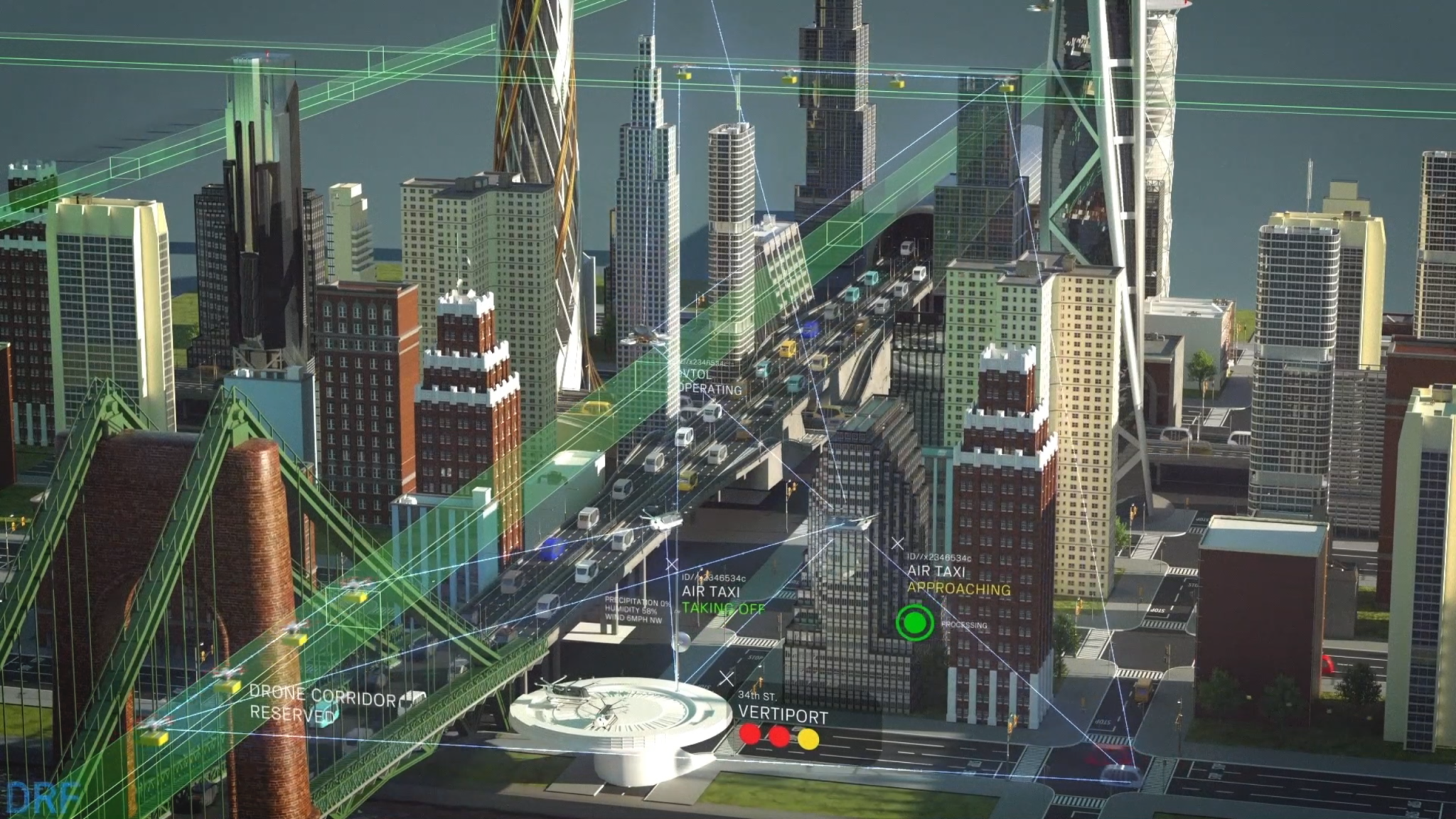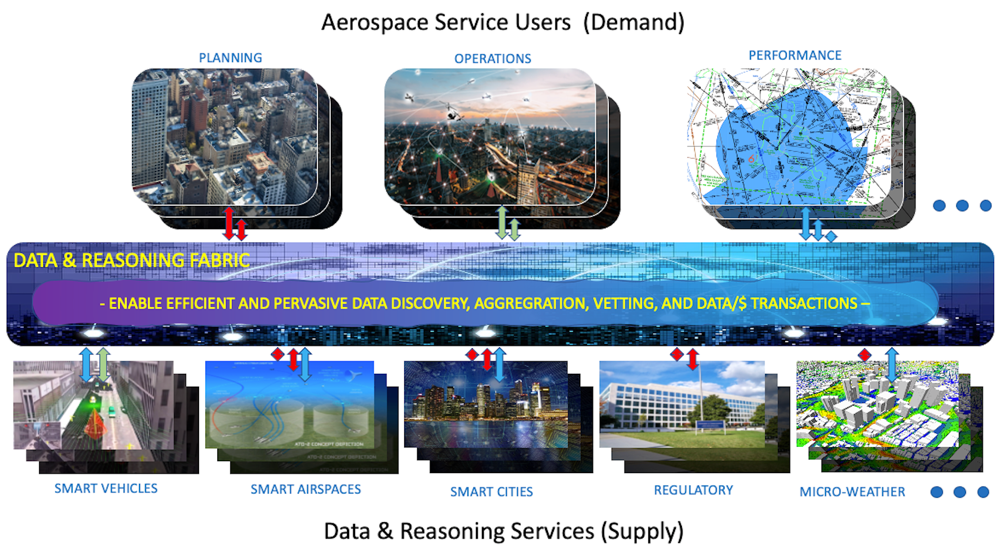How Can a Data & Reasoning Fabric (DRF) Enable Advanced Air Mobility (AAM)?
Throughout recent history, people have created larger and more efficient physical-world systems, often leveraging the proven productivity benefits of data and interwoven digital systems to improve the quality of life. Transportation systems are a main area of this research, given the increasing strain experienced as they are scaled up.
While modern life is built on mobility, most current mobility systems remain rooted in the past. Freedom of movement is constrained to routes defined by fixed path infrastructure such as roads or rail. These constraints shape our perception of distance, location and every aspect of our lives, from the homes we buy to the connections we make and the opportunities we seize. Transportation systems today are labor intensive and heavily dependent on human operators working throughout to enable the basic functions of moving vehicles through the physical world. This has been necessary because human operators possess key capabilities such as perception, judgement and anticipation of behavior that enable intuitive control of these very complex systems.
DRF has a rare opportunity to lead and guide reasoning and decision-making processes between aerial vehicles and ground-based systems in a manner that increases efficiency and safety of operations. Through a self-sustaining commercial marketplace for the data sources and reasoning services required by air-mobility infrastructure, service providers and relevant local-to-federal government organizations, DRF aims to achieve the full potential of advanced mobility to improve the quality of life through pervasive safe air mobility.
2D Environment vs. 3D Environment
Flight environments are subject to increased complexity and workload as compared to ground transportation. In two-dimensional (2D) path-based linear networks, the defined structure of lanes reduces the potential choices and anticipated moves others nearby may make. Human limits are more easily encountered in complex flight environments.
In a three-dimensional (3D) flight environment, humans are only able to safely track and avoid a limited number of other vehicles and obstacles, limiting airspace system density and scale. To achieve a level of functionality for data access and hybrid human/machine reasoning, a digital marketplace is needed to connect vehicles, airspace, cities, infrastructure, and data and reasoning services from the cloud through a web-like ecosystem. DRF can enable this shift to a web-like ecosystem to support safe air mobility. This evolution will resemble technologies such as the Internet that have gone through similar growth.
DRF Goals
DRF provides an open foundational layer (known as DRF marketplace) for data and reasoning exchange among the many systems that must seamlessly interact in the highly complex and dense airspace operations. Our goals are to:
Develop a DRF Accelerator which includes prototype instantiations of key DRF features, including data and reasoning services, a DRF marketplace software architecture and other required functions sufficient to engage end-user representatives of key stakeholder communities in representative use-cases.
Exercise the DRF Accelerator with representatives of key service providers and consumer stakeholder communities in order to demonstrate that the DRF Accelerator provides key data and reasoning functions, enables traditional and emerging air mobility objectives and informs a business plan for a self-sustaining advanced air mobility data and reasoning marketplace
The traditional and emerging air mobility ecosystem of stakeholders, including data providers, infrastructure operators, services providers, flight operators, and others is very complex today. In the future, it promises to be even more complex and fluid as drones, air taxis, and other advanced air vehicles take to the skies in greater numbers and for a broader set of missions. To allow the safe and efficient implementation of this increasingly complex and dynamic airspace, systems enabling pervasive data access and distributed decision making will be required. By providing a self-sustaining commercial marketplace for the data sources and reasoning services required by air-mobility, supporting operators, support entities, regulators, local governments, and the Federal Aviation Administration (FAA).
Our Barriers
In order to support 1000s of vehicle flights in urban environments, elements of the emerging air mobility vision will require ubiquitous advanced air mobility (AAM) operations with system-wide autonomous decision support. To enable these visions, there are multiple inherent barriers to overcome. Three primary barriers are 1) complexity, 2) need for automation, and 3) business viability. Ubiquitous AAM operations will require the interaction of complex systems related to AAM planning, operations, and performance evaluations. Additionally, automated decision-making systems will need to be augmented with human oversight, instead of direct human action for these ubiquitous complex systems. However, automated decisions need to be made where the data exist and, increasingly, data may be too large or dynamic to centralize. As a result, coupled with the inherent barrier of the need for automation, is access to required data. Furthermore, a viable business ecosystem will need to be created, in order to enable industry support for the ubiquitous AAM operations vision.
DRF will address several critical barriers that must be overcome before a widespread data and reasoning fabric can be adopted in AAM environments. Moreover, AAM environments will need access to data and reasoning services, in order to meet the emerging air mobility vision.
DRF Partnerships
Our stakeholders include data providers, infrastructure operators, services providers and flight operators. DRF will establish external partnerships with data and reasoning service providers and end users, in order to test and exercise DRF capabilities. Additionally, collaborations with partners will help the DRF team develop approaches to overcoming the inherent data and reasoning barriers to implementing emerging air mobility.




























